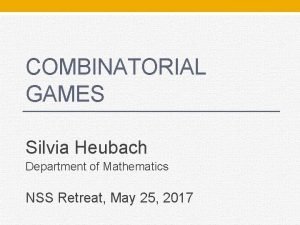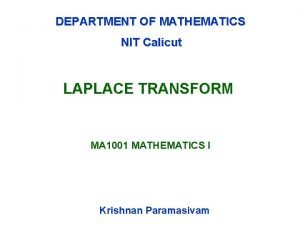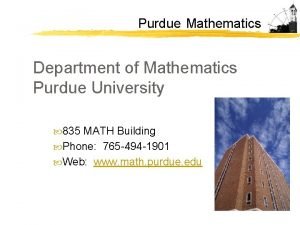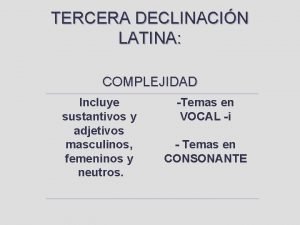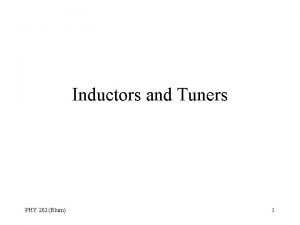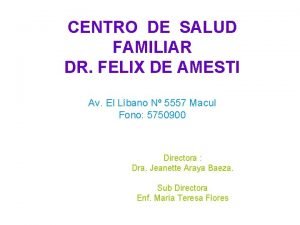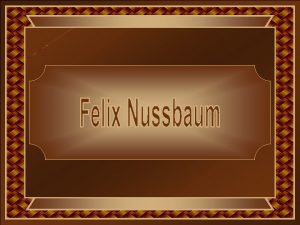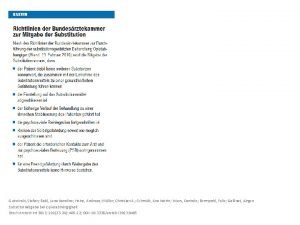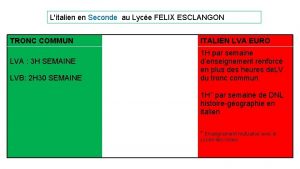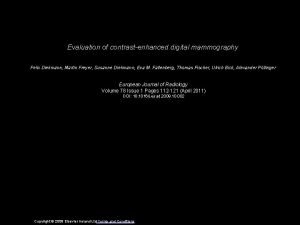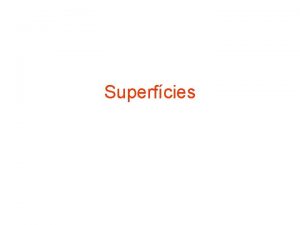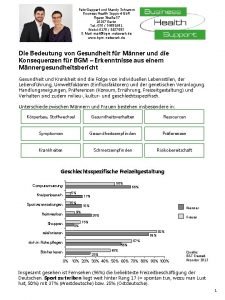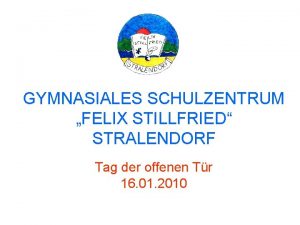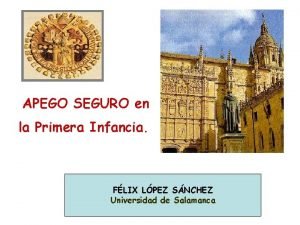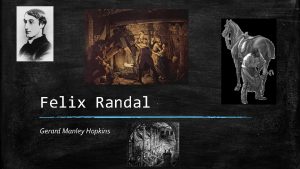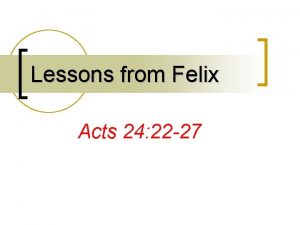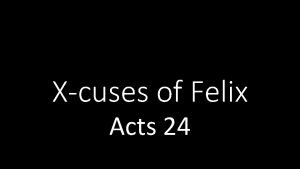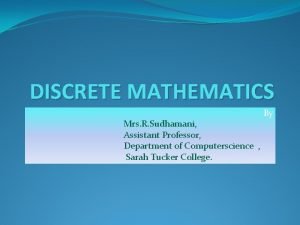Prof J Felix Assistant Professor Department of Mathematics



























- Slides: 27

Prof. J. Felix , Assistant Professor, Department of Mathematics, St. Joseph’s College (Autonomous), Tiruchirappalli- 620002.

NUMERICAL ABILITY

CONTENTS 1. H. C. F. AND L. C. M OF NUMBERS 2. AVERAGE 3. CALENDER 4. PIPES AND CISTERNS

H. C. F. AND L. C. M OF NUMBERS IMPORTANT FACTS AND FORMULAE: 1. If a number a divides another b exactly , we say that a is a factor of b. In these case b is called a multiple of a. 2. Highest Common Factor (H. C. F) : The H. C. F of two or more than two numbers is the greatest number that divides each of them exactly. 3. Co-primes: Two numbers are said to be co-primes if their H. C. F is 1.

. 4. Least common multiple(L. C. M): . The least number which is exactly divisible by each one of the given numbers is called their L. C. M. 5. H. C. F and L. C. M of Fractions:

PROBLEMS 1. Find the H. C. F of 23 X 32 X 5 X 74, 22 X 35 X 52 X 76 , 23 X 53 X 72 Sol: The prime numbers common to given numbers are 2, 5, 7. So H. C. F = Product of least powers of 2 , 5, 7. = 22 X 5 X 72 = 980. 2. Find the H. C. F of 108 , 288 and 360. Sol: 108 = 22 X 33 288 = 25 X 32 360 = 23 X 5 X 32 So H. C. F = 22 X 32 = 36. 3. Find the L. C. M of 23 X 32 X 5 X 74, 22 X 35 X 52 X 76 X 112 , 23 X 53 X 72 X 11. Sol: L. C. M= Product of highest powers of 2, 3 , 5, 7, 11. So L. C. M = 23 X 35 X 53 X 76 X 112.

4. Find the L. C. M of 16, 24, 36 and 54. Sol: 16= 24 24= 23 X 3 36= 22 X 32 54= 2 X 33 So L. C. M = 24 X 33 = 432. 5. Find the H. C. F and L. C. M of Sol: H. C. F of given fractions = L. C. M of given fractions = = =

AVERAGE Important Facts and formulae 1. Average = (Sum of the observations/Number of observations) 2. Suppose a man covers a certain distance at x kmph and an equal distance at y kmph. Then, the average speed = 2 xy/(x+y) kmph.

PROBLEMS 1. Find the average of first 40 natural numbers. Sol: sum of first n natural numbers = n(n+1)/2. Sum of first 40 natural numbers = 40(40+1)/2. = (40 X 41)/2 =820 average= Sum of first 40 natural numbers / no. of observations =820/40=20. 5 2. Find the average of first 20 multiples of 7. Sol : sum of first 20 multiples of 7 = 7+ 14+21+……. . +140 =7(1+2+3+………+20) =7 X 20 X 21/2 =1470 average= 1470/20=73. 5.

3. Find the average of all prime numbers between 30 and 50. Sol: The prime numbers between 30 and 50 are 31, 37, 41, 43, 47. average = (31+37+41+43+47)/5 = 199/5 =39. 8 4. Distance between two stations A and B is 778 km. A train covers the journey from A to B At 84 km per hour and returns back to A with a uniform speed of 56 km per hour. Find the Average speed of the train during the whole journey. Sol: Average speed= 2 xy/(x + y) km p h. x = 84 km p h. y = 56 km p h. required speed= 2 X 84 X 56 / (84 + 56) = 67. 0 km/hr

5. The average of four consecutive even numbers is 27. Find the largest of these numbers. Sol: Let the number be x, x+2 , x+4, x+6. given [x+ (x+2 ) + (x+4) + (x + 6)] /4 = 27 [4 x+12] /4 =27 4[x+3] / 4 =27 x= 27 -3 = 24 largest number = x+6 = 24+6 =30.

CALENDAR Important facts and formulae 1. Odd days: Number of days more than the complete number of weeks in a given period is the number of odd days during that per 2. Leap year : i) Every year which is divisible by 4 is call a leap year. ii) Every 4 th century is a leap year but no other century is a le 3. Ordinary year: A n year which is not a leap year is called an ordinary year. 4. Counting of odd days: i) 1 ordinary year = 365 days = 52 weeks +1 day.

PROBLEMS 1. What was the day of the week on 16 th july 1776? Sol: 16 th July 1776 = 1775 years + Period from 1 st jan. to 16 th July, 1776 Counting the odd days: 1775 years = 1600 years + 100 years + 75 years = 18 leap years + 57 ordinary years =18 X 2 odd days +57 X 1 odd day =36 odd days + 57 odd days = 93 odd days =2 odd days So 1775 years = (0+ 5 + 2 ) odd days = 0 odd day Jan feb mar apr may jun july 31 + 29 + 31 + 30 + 16 =198 days = 2 odd days Total no of odd days = 0+2 = 2 odd days So 16 th july 1776 is Tuesday.

2. What was the day of the week on 15 th August 1947? Sol: 15 th August 1947 = 1946 years +1 st Jan to 15 th Aug 1947 1946 years =(1600 + 300+ 46 )years 1600 =0 odd day 300 years =1 odd day 46 years = 11 leap years +35 ordinary year = (11 X 2 ) + (35 X 1) = 22 + 35 =57 0 dd days =1 odd days 1946 years= 0 + 1 = 2 odd days. Jan Feb Mar Apr May Jun Jul Aug 31 28 31 30 31 15 1 st Jan to 15 th Aug = 227 days. = 3 odd days So 15 th August 1947 = 3+2 = 5 odd days. So 15 th August 1947 is Friday.

4. Counting of odd days: i) 1 ordinary year = 365 days = 52 weeks +1 day. So, An ordinary year has 1 odd day. ii) 1 leap year =366 days =52 weeks +2 days so a leap year has 2 odd days. iii)100 years = 24 leap years + 76 ordinary years. = 24( 52 weeks +2 odd days) + 76(52 weeks + 1 odd day) = 5200 weeks + 124 days = 5217 weeks + 5 days. 100 years contain 5 odd days. so 100 years contain 5 odd days. 200 years contain 10 odd days = 3 odd days. 300 years contain 15 odd days =1 odd days. 400 years contain 20+1=21 odd days= 0 odd day. So 400, 800 , 1200 , 1600 , 2000 , 2400 etc contain 0 odd day. 5. No of 0 odd days 1 2 3 4 5 6 Day Mon Tue Wed Thu Fri Sat Sun

PIPES AND CISTERNS

IMPORTANT FACTS • Inlet: A pipe connected with a tank or a cistern or a reservoir that fills it, is known as an inlet. • Outlet: A pipe connected with a tank or a cistern or a reservoir, emptying it, is known as an outlet.

FORMULAE q If a pipe can fill a tank in x hours , then part filled in 1 hour = 1/x. q If a pipe can empty a full tank in y hours , then part emptied in 1 hour = 1/y.

q If a pipe can fill a tank in x hours and another pipe can empty the full tank in y hours (where y > x), then ( on opening both the pipes), the net part filled in 1 hour = q If two pipes A and B can fill a tank in hours and hours respectively and another pipe can empty the full tank in y hours, then (on opening both the pipes), the net part filled in 1 hour =

q If a pipe can fill a tank in x hours and another pipe can empty the full tank in y hours (where x > y), then (on opening both the pipes), the net part filled in 1 hour = .

PROBLEMS 1. Two pipes A and B can fill a tank in 36 hours and 45 hours respectively. If both the pipes are opened simultaneously, how much time will be taken to fill the tank? Exercise i)Two pipes A and B can fill a tank in 20 and 30 minutes respectively. If both the pipes are used together , then how long will it take it to fill the tank? a)12 min b)15 min c)25 min d)50 min [Note: If a pipe can fill a tank in x hours, then part filled in 1 hour = 1/x]

Ans: a)12 min b)15 min c)25 min d)50 min 2. Two pipes can fill a tank in 10 hours and 12 hours respectively while a third pipe empties the full tank in 20 hours. If all the three pipes operate simultaneously, in how much time will the tank be filled? . Exercise a)Pipes A and B can fill a tank in 5 and 6 hours respectively. Pipe C can empty it in 12 hours. If all the three pipes are opened together , then the tank ill be filled in : i)30/17 hr ii)30/11 hrs iii)60/17 hrs iv)9/2 hrs. [Note: If y > x , then part filled in 1 hour = 1/x- 1/y. ]

Ans: i)30/17 hr ii)30/11 hrs iii)60/17 hrs iv)9/2 hrs. 3. If two pipes function simultaneously, the reservoir will be filled in 12 hours. One pipe fills the reservoir 10 hours faster than the other. How many hours does it take the second pipe to fill the reservoir? EXERCISE a)Two pipes A and B together can fill a cistern in 4 hours. Had they been opened separately, then B would have taken 6 hours more than A to fill the cistern. How much time will be taken by A to fill the cistern separately? i)1 hr ii)2 hrs iii)6 hrs iv)8 hrs

Ans: i)1 hr ii)2 hrs iii)6 hrs iv)8 hrs 4. A cistern has two taps which fill it in 12 minutes and 15 minutes respectively. There is also a waste pipe in the cistern. When all the three are opened, the empty cistern is full in 20 minutes. How long will the waste pipe take to empty the full cistern?

5. Two pipes can fill a cistern in 14 hours and 16 hours respectively and it is found that due to leakage in the bottom it took 32 minutes more to fill the cistern. When the cistern is full, in what time will the leak empty it?

6. Two pipes A and B can fill a tank in 24 minutes and 32 minutes respectively, after how much time B should be closed so that the tank is full in 18 minutes?

THANK YOU
 Promotion from associate professor to professor
Promotion from associate professor to professor Cuhk assistant professor salary
Cuhk assistant professor salary Ali ahmed is a mathematics professor who tries to involve
Ali ahmed is a mathematics professor who tries to involve Department of mathematics
Department of mathematics Nit calicut mathematics department
Nit calicut mathematics department Science dadeschools
Science dadeschools Math.purdue.edu ma261
Math.purdue.edu ma261 Felix sparks
Felix sparks Ga toch weg met je mindfulness
Ga toch weg met je mindfulness Duna flix
Duna flix Omnis omne declinado
Omnis omne declinado Phy
Phy Johan felix
Johan felix Vacunatorio felix de amesti
Vacunatorio felix de amesti Felix nussbaum werkverzeichnis
Felix nussbaum werkverzeichnis Felix horch
Felix horch Dr hamza andreea
Dr hamza andreea Bald lena
Bald lena Felix baumgartner salary
Felix baumgartner salary Lycée felix esclangon
Lycée felix esclangon Felix diekmann
Felix diekmann Felix candela
Felix candela Mandy schramm
Mandy schramm Principales obras de felix lope de vega
Principales obras de felix lope de vega Felix stillfried
Felix stillfried Félix lópez sánchez
Félix lópez sánchez Felix obschonka
Felix obschonka Dr. felix schmutterer
Dr. felix schmutterer



